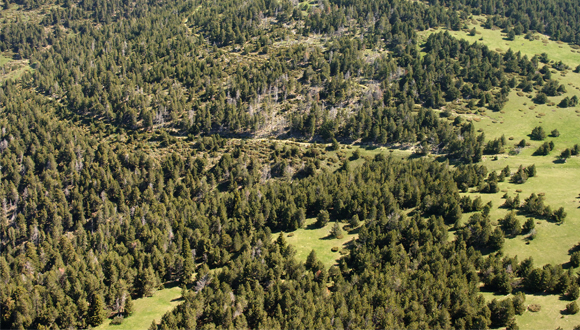Scientists study the chemical language of plants from the sky
A study carried out by scientists at the CREAF and the CSIC has shown that the reflectance PRI index allows for the quantification of gasses emitted by plants in order to communicate or in situations of stress. This index is calculated by measuring the light that vegetation reflects with the help of photosensors on planes or with satellite images.

A group of experts at the CREAF and the CSIC has proven that it is possible to estimate continuously and at a distance the amount of volatile organic compounds (VOCS) that plants produce over large areas. According to the results of the article published in Nature Communications, the Photochemical Reflectance Index (PRI, for its acronym in English) is related to the amount of gases plants emit in order to communicate – isoprene and monoterpenes in the case studies section. So, if you measure the light that plants reflect, flying over the vegetation with aircraft equipped with sensors or via satellite imagery, we can calculate the PRI in a very simple way and, therefore, estimate quickly the amount of gases that are being emitted.
"The use of remote sensing will allow us to study on a large scale the amount of VOCs that the vegetation is pouring into the atmosphere and will be a step forward towards a much better prediction of related atmospheric chemistry, for example how much ozone will be created in the low layers of the atmosphere in sensitive areas or in specific moments," says Josep Peñuelas, CSIC research professor and researcher at the CREAF.
"The use of remote sensing would be a step forward to discerning the effects of VOCS on the formation of aerosols and local and regional climate," says Josep Peñuelas.
Until today, scientists quantified these gases with specific measures in the field and with the help of simulations that facilitated current mathematical models.
Solar radiation, vegetation and exhaust pipes: an undesirable cocktail
Terrestrial plants emit gases into the atmosphere that protect themselves from stress, communicate with other plants or even attract pollinators or scare off predators. Emissions of VOCs are changing atmospheric chemistry and can become polluting gases such as ozone, if they react with gases from industrial or with the fumes of combustion cars, planes and boats. This, added to the high levels of solar radiation in the summer periods, favors the generation of ozone in some areas of the peninsula and makes Spain the EU country that has more days per year surpassing the ozone limits recommended by the European Agency for the Environment.







